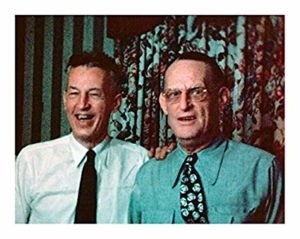Summary: The 12-step program has a rich history rooted in the struggles and triumphs of its founders, Bill W.Bill W., formally known as William Griffith Wilson, is a name that resonates deeply within the realms of addiction recovery and self-help. As one of the co-founders of Alcoholics Anonymous (AA), Bill W.'s life journey and struggles with alcoholism are meticulously detailed in the Big Book of AA, a f... More and Dr. Bob S. Their vision to help others recover from addiction led to the creation of Alcoholics Anonymous and the development of the 12-step program through a process of experimentation and guidance from the principles of the Oxford GroupA Christian movement of self-improvement, highly popular in the 1930s Its founder Frank Buchman believed all human problems derive from selfishness. The founders of AA were members and used many of the tenets of the movement for the 12-steps. More. Today, the 12-step approach continues to be a vital resource for individuals seeking recoveryThe process by which addicts attempt to break the hold a certain substance or behavior has on their lives. This can refer to participation in a wide variety of methods. What they all have in common, is a sense that life is improving and the addict is regaining control. More from addictive and compulsive behaviorsThese are behaviors in engaging in due to a strong urge to do so. Compulsion may be difficult to control but is mostly manageable. If compulsion turns into addiction, the problem becomes more severe. More, with its impact and success widely recognized by treatmentA blanket term for concentrated efforts to help addicts transition to a healthier life. These can include any of the following (in isolation or combination): therapy, counseling, medication, harm reduction, or moderation. More centers and organizations like SAMHSA.
What is the 12-step Program?
The 12-step program serves as a set of guiding principles for individuals who are struggling with various forms of addiction, compulsions, or behavioral issues.
The 12-step program was first established by Alcoholics AnonymousThe original 12-step fellowship, formed in 1935, to help alcoholics, regain control over their lives. It remains the largest 12-step organization and has contributed to the sobriety of millions worldwide. Read more about Alcoholics Anonymous More (AA) and has since been adapted for a number of different support groups, including Narcotics Anonymous, Cocaine Anonymous, and Debtors Anonymous.
However, the question remains: who exactly was responsible for creating the 12-step program?
The Birth of Alcoholics Anonymous
Alcoholics Anonymous, commonly known as AA, is a powerful global support network for those seeking to overcome alcoholism. This incredible organization has been providing hope and recovery for more than 85 years, since its founding by Bill Wilson and Dr. Bob Smith in 1935.

According to the AA official website, Bill Wilson, a successful stockbroker, had struggled with alcoholism for many years before he had a life-changing spiritual experience in 1934. This experience fueled his passion to help others facing the same struggles, and he found an ally in Dr. Bob Smith, a surgeon who was also grappling with alcoholism.
The two men formed a close friendship, combining their experiences and principles of spirituality, honesty, and self-reflection to create the 12 stepsThe term "12 steps" refers to the core principles of the approach to addiction exemplified by Alcoholics Anonymous and other similar groups. The 12 steps are a set of guidelines designed to help individuals overcome addiction and rebuild their lives. They were created by the founders of Alcoholics A... More of Alcoholics Anonymous. These steps have become a roadmap for individuals to overcome alcoholism and achieve a life of sobrietyIn 12-step programs, an individual is sober when they are no longer partaking in the behavior or substance to which they are addicted and living a better life following the program. Both are necessary to achieve sobriety. More and peace.
In June 1935, Bill and Dr. Bob held the first AA meetingAA holds regular meetings of various types to support the recovery of its members from alcoholism. In these meetings, members read relevant literature and share thoughts on their recovery. These events are designed to provide the social glue reinforcing recovery. More in Akron, Ohio, attended by several alcoholics seeking a solution to their problem. The AA program quickly gained popularity and spread to cities across the United States. Today, AA is a worldwide organization with over two million members in over 180 countries.
When Other 12 Step Programs Were Founded
Dates of when 12 step programs were founded.The Evolution of the 12 Steps
The evolution of the 12 steps of Alcoholics Anonymous (AA) is a remarkable story of hope and determination. “The Program”, which has become a cornerstone of the organization and a widely recognized model for addiction recovery, was born out of the personal struggles of its co-founders, Bill W. and Dr. Bob S. These two recovering alcoholics were determined to find a solution to their own addictions and help others do the same.
The Oxford Group was a Christian organization that placed a strong emphasis on spirituality, self-reflection, and serving others, and these values are reflected in the 12 steps. Bill W. and Dr. Bob S. honed the programThis refers to any official course of treatment for addiction. This could be anything from in-patient facilities, to 12-step programs to harm-reduction programs. More until it became the 12-step program that is still used today.
The 12 steps were first documented in the “Big Book” of AA, officially titled “Alcoholics Anonymous: The Story of How Many Thousands of Men and Women Have Recovered from Alcoholism,” which was published in 1939. This book has become the main source for AA meetings and is widely quoted in all AA and other 12-step literature. The “Big BookThe basic text of AA was the first to methodically introduce the 12-steps. It is still the main source for meetings and is quoted in just about all AA and other 12-step literature. the Library of Congress named it one of the 88 “Books that shaped America.” Read more about the Big Book of AA. More” has even been recognized for its significance by the Library of Congress, which named it one of the 88 “Books that shaped America.”
Today, the 12 steps of AA have evolved into a widely recognized model for addiction recovery, inspiring numerous other 12-step programs and serving as a guide for individuals seeking to overcome addiction and achieve a life of sobriety. The program continues to offer hope and support to millions of individuals struggling with alcoholism and other forms of addiction around the world. It is a testament to the hard work and dedication of Bill W. and Dr. Bob S. and their unwavering commitment to helping others find recovery from addiction.
Fun Fact:
When someone uses the term ‘Friends of Bill’ or ‘Friends of Bill W.’, it’s a discreet way of saying that someone is a memberAn individual who attends 12-step program meetings and has the desire to overcome addiction. More of Alcoholics Anonymous. The term has found its way into various contexts such as cruise ships, biker gatherings, and other public events as a subtle call for mutual support or a sign of shared sobriety.
Sources:
Alcoholics Anonymous. (n.d.). Our History. Retrieved from https://www.aa.org/aa-history
Books that Shaped America. LoC. Retrieved from www.loc.gov/exhibits/books-that-shaped-america/1900-to-1950.html#obj24






